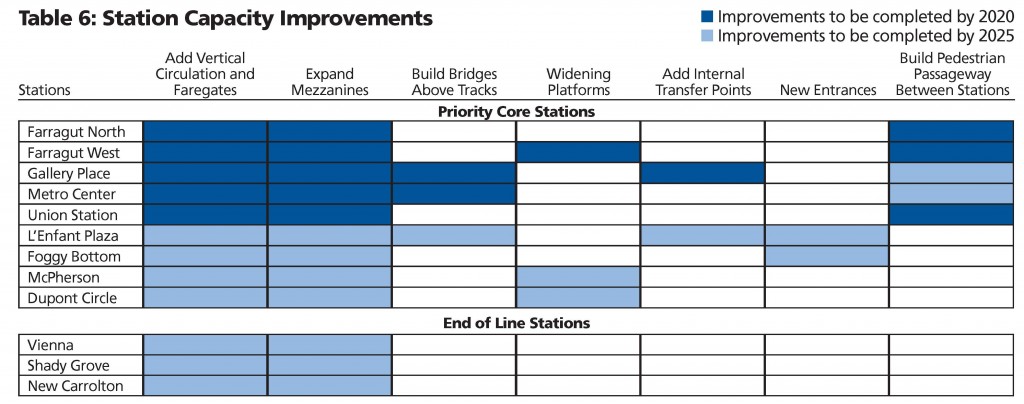Improving Core Metrorail Stations
Improving and expanding capacity at high ridership stations will ensure safe and efficient operations and facilitate passenger movements from street-level to platform as well as transfers between lines. The proposed stations, most of which are in the system’s core, already experience crowding or would reach capacity by 2025. Proposed improvements vary from adding escalators and stairs to building pedestrian passageways connecting platforms within a station and between stations.
Purpose and Need
Station capacity is the maximum number of passengers that can safely travel through facilities within a station. Expanding capacity at high ridership stations ensures safe and efficient movements of passengers and trains throughout the Metro system. The strong ridership growth Metro enjoyed since opening has already placed strains on some stations, where travel demand exceeds the designed capacity, especially in the system’s core. Metro 2025 identifies a group of stations that urgently need significant capacity expansions to alleviate current and anticipated congestion and support a strong economy and sustainable development in the region.
Benefits
- Eliminates congestion bottlenecks at stations
- Accommodates ridership growth
- Supports operations of 100 percent eight-car trains
- Enhances safety for both passengers and operations
- Enhances connections to other transportation modes
- Supports additional development around stations
- Reduces passenger travel time and facilitate smooth movements within stations
- Improves rail on-time performance
- Diverts transferring passengers from trains to walking paths and relieve crowding on the most congested lines and in the most congested stations
Considerations
- Metro’s regional capital funding agreement does not adequately incorporate station expansion. Current regional capital funds typically apply to infrastructure renewal and expansion for fleet, tracks and yards, as well as station rehabilitation.
- Current funding sources, based on Metro Board direction, focuses heavily on state of good repair and have minimal funding for capacity expansion. New funding sources will be needed to pay for these improvements.
- Metro would need to maintain existing operations and reduce construction impacts on operations, passengers and surrounding businesses.
- Metro would need to identify potential structural and right-of-way impacts on stations and adjacent properties.
Status of Ongoing/Previous Projects
The proposed station improvements are built upon major system plans and individual station capacity studies, including:
- Core Capacity Study (2002)
- Pedestrian Passageway Studies (2004 and 2005) (Farragut North – Farragut West, Gallery Place – Metro Center)
- Station Access and Capacity Study (2008), proposing capacity improvements for the entire system
- Union Station Access and Capacity Study (2011)
- Gallery Place-Chinatown Capacity Study (ongoing, 2013)
- L’Enfant Plaza Capacity Study (ongoing, 2013)
FY2014-2019 Investments
These investments are already included and funded in Metro’s current six-year CIP:
- Construction of Union Station and Gallery Place station access and capacity improvements
- Planning for additional stations
Total- $100M
Order of Magnitude Cost Estimate
$1 billion ($2012)
Some of the proposed improvements were identified in previous studies while others require further detailed analysis. Costs for individual stations may vary by improvement type, station layout and project complexity.
Timeline
For more information:
Download both the full Momentum plan and the Executive Summary.
Regional support is important to making Momentum a reality! A number of regional stakeholders have already endorsed Momentum. Please sign on and add your name to endorse Momentum and send the message that public transit is vital to the National Capital Region.




In the meantime why not add the virtual connection between Metro Center and Gallery Place like the Farraguts. For Orange/Blue and Green/Yellow connections it could shave 10 minutes off travel time in off peak hours. Would also reduce congestion for people that wait for the red line ony to hop off one stop later.